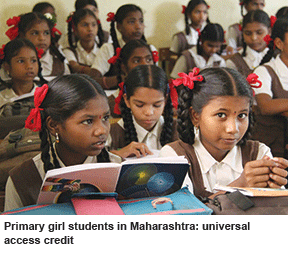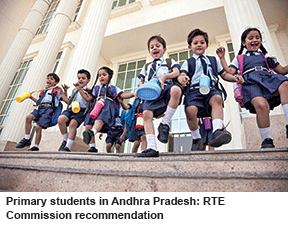 Unesco (united nations Educational, Scientific and Cultural Organisation) released its annual EFA Global Monitoring Report (GMR) 2015, simultaneously in Delhi, Paris and New York on April 9, forty days before a new agenda is scheduled to be adopted at the forthcoming World Education Forum in Incheon (Republic of Korea) from May 19-22.
Unesco (united nations Educational, Scientific and Cultural Organisation) released its annual EFA Global Monitoring Report (GMR) 2015, simultaneously in Delhi, Paris and New York on April 9, forty days before a new agenda is scheduled to be adopted at the forthcoming World Education Forum in Incheon (Republic of Korea) from May 19-22.
In 2000, at the World Education Forum in Dakar (Senegal), 164 governments agreed on the Dakar Framework for Action, popularly known as the Education for All (EFA) agenda. It set six goals — expanding and improving early childhood care and education; ensuring all children, particularly girls, have access to free and compulsory education of good quality; young people and adults have access to appropriate learning and life skills; 50 percent improvement in adult literacy by 2015; gender equality in education by 2015, and measurable improvements in literacy, numeracy and essential life skills. The recently released EFA Global Monitoring Report 2015 is a progress report on the Dakar Framework, highlighting gaps and offering recommendations for debate at the World Education Forum in Incheon.
With specific reference to India, GMR 2015 says the country has made considerable progress in early childhood care and education (ECCE) with the percentage of children in the 0-5 age group attending anganwadis and/or pre-primaries having risen from 20 percent in 1999 to 60 percent in 2012. However, it also notes that the corresponding increase in Nepal is from 15 to 85 percent and in neighbouring Pakistan from 64 to 78 percent.
For providing universal access to primary school, GMR 2015 gives India full credit for achieving almost 100 percent enrolment of girls and boys — up from 85 percent in 1999. Moreover, it estimates the number of children out of primary school at a mere 1.4 million cf. Pakistan’s 5.4 million.
With reference to transition to lower and upper secondary education (appropriate learning and life skills), the report doesn’t specifically comment on India’s progress. On average, lower secondary gross enrolment ratio (GER) rose from 60 to 81 percent between 1999 and 2012.
South and West Asia’s progress in accelerating adult literacy is also a disappointment. Without mentioning India specifically, the report laments that while the adult illiteracy rate was projected to fall by 26 percent between 2000 and 2015, the reduction will fall short of the target by 50 percent. With adult education not on the radar screens of the Central and state governments, there’s no way that India’s record is likely to be better.
However, on the issue of gender parity, India has achieved considerable progress. “Of the eight countries with data, four were at gender parity in 2012, with Bhutan, India and the Islamic Republic of Iran reaching the target over the period, while parity has been achieved in Sri Lanka since 1999… Gender disparities at the expense of girls have reduced significantly in India where the GPI stood at 0.70 in 1999 and rose to 0.94 in 2012, with the country likely to achieve parity in 2015,” says the report.
And lastly on the issue of installing systems to measure improvements in literacy, numeracy and life skills education, GMR 2015 commends governments (and NGOs) for their initiatives. “Of the nine countries in the region, only the Islamic Republic of Iran and Nepal had conducted a national assessment of learning outcomes before 1999. Since then, all nine countries have carried out at least one national assessment; many have done so on multiple occasions,” says the report. In particular, it commends the Mumbai-based NGO Pratham for publishing its Annual Status of Education Report (ASER) since 2005.
Quite obviously, for diplomatic reasons GMR 2015 is couched in polite language. While India’s shortcomings are glossed over, its progress is commended. GMR 2015 is less a report and more a note of encouragement.
Autar Nehru (Delhi)
Inclusion failure diagnosis
Five years after the right of Children to Free and Compulsory Education (RTE) Act, 2009 became law on April 1, 2010, a nationwide study conducted jointly by IIM-Ahmedabad, the Delhi-based Central Square Foundation, Accountability Initiative, and Vidhi Centre for Legal Policy, indicates that compliance with s.12 (1) (c) of the Act — which requires private schools to allot 25 percent of seats in class I to underprivileged children in their neighbourhood — is abysmal. According to State of the Nation: RTE Section 12 (1) (c), released in Delhi on March 24, of the estimated 2.1 million seats in private schools which should be made available to children of EWS (economically weaker sections) households, only 610,000 (29 percent) have been allotted.
The painstakingly compiled 150-page report examines the causes and effect of the failure of the Central and state governments to implement s.12 (1) (c) from the administrative, legal, and financial perspectives to highlight the challenges, and recommends suggestions for improvement.
To give effect and put more teeth into this unprecedented inclusive provision which was opposed tooth and nail by private education providers before the Supreme Court in the Society of Unaided Private Schools of Rajasthan vs. Union of India (Writ Petition (C) No.95 of 2010) upheld it by a 2-1 majority subject to exclusion of minority and boarding schools, the authors of State of the Nation make several valuable recommendations.
The first among them is a forthright call for reversal of the exemption granted by the apex court to minority schools. “The exemption allows the creation of a loophole which if left unplugged, could unravel all the efforts that have been made in moving to a more inclusive schooling system and society,” says the report.
Secondly, it calls for clarity and transparency of the RTE Rules which are framed by state governments, and tend to vary widely.
“There are still far too many rules and procedures that remain unspecified or inadequately clarified by various governments the ambiguity in rules also increases the probability of misuse and corruption,” opine the authors of the report.
But perhaps the most important suggestion is the appointment of a “one window” RTE Commission directly accessible by all stakeholders which according to the authors is “a necessity to translate the potential of RTE to a living reality”.“The commission should be an independent body that not only plays the role of an ombudsperson but also has the ability to pass binding orders.”
In its concluding remarks, the report describes s.12 (1) (c) of the RTE Act as “work in progress”. “For the mandate to achieve its true potential, it should not be seen in isolation but as a necessary response in a society that needs greater social inclusion. We believe the mandate provides a compelling platform for various actors — governments, private schools, civil society organisations, educators and researchers — to step up.”
Undoubtedly, this is a valuable study which is simultaneously a plea for effective inclusion. However, the authors seem to believe there’s a national consensus on the issue of the State transferring its obligation — or at least a part of it — to provide acceptable quality free and compulsory education to private educators engaged in the ‘occupation’ of education. This is an erroneous presumption and to a great extent explains the poor implementation of s.12 (1) (c).
The greater duty of the Central and state governments is to ensure that the education provided in publicly-funded government schools is of such quality that s. 12 (1) (c) becomes redundant.
Special Correspondent (Delhi)